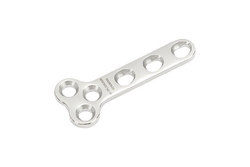TPLO DCP Plate, 3.5mm x 55mm, 6-Hole
Supplied By: Veterinary Instrumentation (TPLO353555)
SKU
047131
Unit of
Measure
Pack
Type Each
Case
Qty 1
Product Description
TPLO closing wedge or Closing Wedge Ostectomy Tibial Plateau Levelling Osteotomy (CWO-TPLO) was the original version of TPLO surgery that preceded the curved osteotomy Slocum TPLO procedure; the latter has since gained widespread use worldwide. CWO-TPLO was originally popular in some territories when availability of the Slocum TPLO procedure training courses, equipment and implants was limited and difficult to access. CWO-TPLO surgery offers advantages and disadvantages compared to TPLO surgery. Advantages of CWO-TPLO surgery compared to TPLO surgery: - CWO-TPLO is simpler to perform, there is more room for error in terms of osteotomy positioning, it requires less specialised equipment and there is arguably less risk of damage to the popliteal artery. - CWO-TPLO can be performed in any dog, regardless of Tibial Plateau Angle (TPA). Conversely, for TPLO surgery the higher the TPA, the higher the required rotation of the tibial plateau segment for TPLO surgery therefore the less contact at the osteotomy site post rotation and reduction, and the larger the amount of tibial tuberosity that is left exposed that could potentially fracture. CWO-TPLO is arguably simpler, safer and more appropriate in dogs with high TPAs. However, disadvantages of CWO-TPLO surgery include: - Post-reduction, the transverse CWO-TPLO osteotomy appears to be inherently less stable than the curved CWO-TPLO osteotomy. - CWO-TPLO moves the distal tibia relative to the entire proximal tibia i.e. the plateau is not disassociated from the tibial tuberosity. Therefore with the greater stifle flexion that is assumed following CWO-TPLO, the tibial tuberosity assumes a more distal / flexed position relative to the femoral trochlear sulcus. In turn, the patella seems to have a more distal position in the trochlear sulcus that could approach patella baja, although this does not seem to be a clinically significant problem. Arguably this could be a positive feature as the patella may engage the femoral trochlear sulcus more reliably, making patellar luxation less likely, although this is unproven. - It is not possible to correct concurrent cruciate ligament disease and patellar luxation with CWO-TPLO surgery as the relationship between the tibial tuberosity and the tibial plateau is not changed. In contrast, TPLO surgery separates the plateau from the tuberosity therefore it is possible to treat concurrent patellar luxation and cranial cruciate disease; the plateau is rotated to reduce the TPA and concurrently the tibial tuberosity is rotated medially, or rarely laterally. Tips and tricks for CWO-TPLO surgery. There are many different ways to perform this operation with subtle differences in technique. Here are some tips to make it as straightforward as possible: - When planning the wedge, the angle of the wedge is calculated from the TPA but the size of the wedge should be smaller than a full cranio-caudal wedge of bone from he proximal tibia. This is to preserve as much bone stock as possible, and to minimise size discrepancies of the osteotomised surfaces of the proximal and distal tibia. - Use a cranial K-wire and tension band to make osteotomy reduction easier and more stable. - Plan and pre-place the holes for the distal K-wire and proximal tension band prior to making the osteotomy. This will make implant placement and osteotomy reduction simpler later. - Once the ostectomy is complete, place the K-wire in the cranial cortex of the distal fragment, aim into the proximal segment, hold the osteotomy in reduction and drive the K-wire into the proximal segment. This will stabilise the reduction. - Ensure that reduction and alignment are good, particularly that there is no axial malalignment of the tibia. Then place the cranial tension band, placing it through the hole in the tibial tuberosity proximally and the K-wire distally. - Place the medial plate; various options are possible including a DCP, T plate, TPLO plate and locking plates. Remember that this is an inherently unstable osteotomy in the cranial to caudal plane. Coupled with a short proximal tibial segment, this makes stable fixation more of a challenge. Using locking screws proximally and/or as long a plate as possible should help to stabilise the osteotomy as good as possible.
